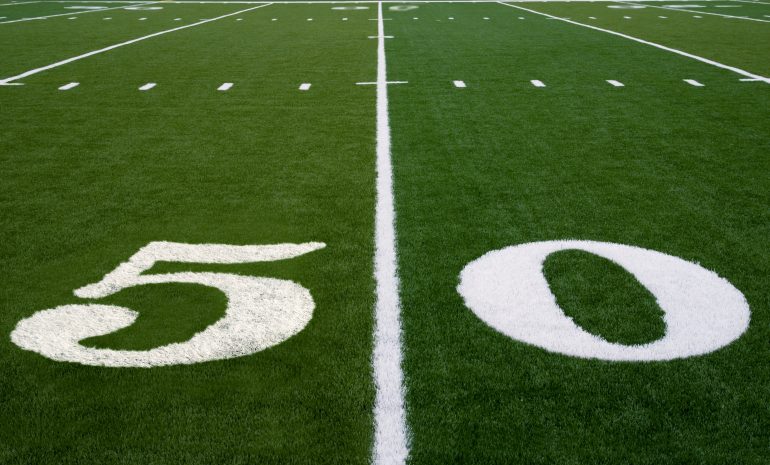When I first examined the Seahawks’ toxic differential after four games they ranked seventh in the league with a +7 differential, which put them on pace for a +28 for the season. A top ten berth is hardly a reason to panic, but that differential was low enough to make me think that a repeat of the 2013 team’s NFL-best +59 finish from a year ago was an unattainable pipe dream for this year’s squad. Ten games later, here’s how they currently rank against the rest of the NFL:
table.quickTable {
border: 1px solid #CCC;
font-family: Arial, Helvetica, sans-serif;font-size: 13px;
}
.quickTable td {
padding: 4px;
border: 1px solid #ccc;
}
| Rank | Team | Exp Pl Diff | TO Diff | Toxic Diff |
| 1 | Seattle Seahawks | 47 | 8 | 55 |
| 2 | Denver Broncos | 38 | 6 | 44 |
| 3 | Green Bay Packers | 9 | 15 | 24 |
| 4 | Dallas Cowboys | 19 | 2 | 21 |
| 5 | Cleveland Browns | 8 | 7 | 15 |
| 6 | Washington | 24 | -9 | 15 |
| 7 | Houston Texans | 2 | 12 | 14 |
| 8 | Buffalo Bills | 3 | 10 | 13 |
| 9 | San Francisco 49ers | 8 | 4 | 12 |
| 10 | New England Patriots | -1 | 11 | 10 |
| 11 | Detroit Lions | 2 | 8 | 10 |
| 12 | Baltimore Ravens | 7 | 2 | 9 |
| 13 | Indianapolis Colts | 11 | -4 | 7 |
| 14 | Carolina Panthers | 5 | 1 | 6 |
| 15 | Pittsburgh Steelers | 1 | 4 | 5 |
| 16 | Atlanta Falcons | 3 | 2 | 5 |
| 17 | St. Louis Rams | 6 | -1 | 5 |
| 18 | Arizona Cardinals | -8 | 12 | 4 |
| 19 | Miami Dolphins | -1 | 3 | 2 |
| 20 | Minnesota Vikings | -2 | -1 | -3 |
| 21 | San Diego Chargers | -2 | -2 | -4 |
| 22 | New York Jets | -1 | -7 | -8 |
| 23 | New Orleans Saints | 3 | -11 | -8 |
| 24 | Philadelphia Eagles | -4 | -9 | -13 |
| 25 | Kansas City Chiefs | -10 | -5 | -15 |
| 26 | Cincinnati Bengals | -14 | -2 | -16 |
| 27 | Tennessee Titans | -14 | -9 | -23 |
| 28 | Tampa Bay Buccaneers | -17 | -10 | -27 |
| 29 | New York Giants | -27 | -5 | -32 |
| 30 | Chicago Bears | -26 | -8 | -34 |
| 31 | Jacksonville Jaguars | -33 | -8 | -41 |
| 32 | Oakland Raiders | -38 | -16 | -54 |
And here’s the raw data as well:
table.quickTable {
border: 1px solid #CCC;
font-family: Arial, Helvetica, sans-serif;font-size: 13px;
}
.quickTable td {
padding: 4px;
border: 1px solid #ccc;
}
| Team | Exp Pass | Exp Run | TO | Exp P All | Exp R All | TA |
| Arizona Cardinals | 71 | 24 | 13 | 79 | 24 | 25 |
| Atlanta Falcons | 90 | 22 | 20 | 83 | 28 | 24 |
| Baltimore Ravens | 70 | 39 | 17 | 84 | 18 | 19 |
| Buffalo Bills | 71 | 18 | 20 | 54 | 32 | 30 |
| Carolina Panthers | 78 | 29 | 21 | 72 | 30 | 22 |
| Chicago Bears | 58 | 29 | 28 | 89 | 24 | 20 |
| Cincinnati Bengals | 52 | 32 | 21 | 71 | 27 | 19 |
| Cleveland Browns | 82 | 25 | 20 | 70 | 29 | 27 |
| Dallas Cowboys | 71 | 43 | 23 | 63 | 32 | 25 |
| Denver Broncos | 82 | 33 | 15 | 65 | 12 | 21 |
| Detroit Lions | 78 | 19 | 16 | 77 | 18 | 24 |
| Green Bay Packers | 73 | 40 | 10 | 71 | 33 | 25 |
| Houston Texans | 60 | 32 | 19 | 66 | 24 | 31 |
| Indianapolis Colts | 101 | 24 | 28 | 78 | 36 | 24 |
| Jacksonville Jaguars | 60 | 26 | 26 | 87 | 32 | 18 |
| Kansas City Chiefs | 59 | 31 | 16 | 56 | 44 | 11 |
| Miami Dolphins | 61 | 31 | 20 | 60 | 33 | 23 |
| Minnesota Vikings | 62 | 25 | 18 | 60 | 29 | 17 |
| New England Patriots | 81 | 27 | 12 | 82 | 27 | 23 |
| New Orleans Saints | 84 | 34 | 23 | 76 | 43 | 16 |
| New York Giants | 71 | 23 | 27 | 74 | 47 | 22 |
| New York Jets | 44 | 37 | 22 | 63 | 15 | 11 |
| Oakland Raiders | 49 | 17 | 27 | 77 | 27 | 11 |
| Philadelphia Eagles | 73 | 36 | 34 | 81 | 32 | 25 |
| Pittsburgh Steelers | 88 | 29 | 18 | 76 | 35 | 17 |
| San Diego Chargers | 76 | 21 | 17 | 73 | 26 | 15 |
| San Francisco 49ers | 58 | 32 | 19 | 58 | 24 | 23 |
| Seattle Seahawks | 62 | 53 | 12 | 48 | 20 | 20 |
| St. Louis Rams | 64 | 30 | 21 | 56 | 35 | 23 |
| Tampa Bay Buccaneers | 75 | 19 | 31 | 78 | 33 | 21 |
| Tennessee Titans | 81 | 18 | 25 | 69 | 44 | 16 |
| Washington | 79 | 35 | 25 | 68 | 22 | 16 |
(Note: as before, explosive plays are defined here using Brian Billick’s criteria, i.e. runs of 12 or more yards and passes of 16 or more yards.)
As it turns out, the 2014 Hawks disagreed with my assessment, and I’ve never been happier to be proven wrong. Not only are the Seahawks number one again, they have a legitimate shot at breaking their championship season mark – if they keep up this pace for their last two games, they’ll end the year with a +62 differential. I’ve been racking my brain trying to come up with ways to express just how ridiculously awesome this stat line is, and the only things that have come to mind are ridiculous analogies along the lines of “if this differential was a movie, it’d star Rambo and Snake Plissken battling an army of Terminators riding fire-breathing tyrannosaurus rexes.” In short, it’s so good that it’s knocked my ability to describe things back into the fourth grade.
The raw numbers compared to those from last year’s team at this same point in the season back up what most of us have already sensed from watching the games this year. The offensive mix is a bit different, with more explosive runs (53 versus 45 in ‘13) and fewer explosive passes (62 versus 73) on offense, but the total number of explosive plays is pretty close (115 versus 118). On defense, the pass defense is comparably strong (48 explosive passes allowed versus 46), and the run defense is even stingier than it was a year ago (20 explosive rushes allowed versus 28).
The Seahawks are better at protecting the ball this year (12 turnovers versus 16 in 2013), but they’ve also produced fewer takeaways (20 versus 30), which is why the 2014 team has a much lower turnover differential (+8 versus +14). Still, those takeaway numbers represent a distinct improvement over the first part of the year: they averaged just one takeaway per game through their first four games, but have averaged 1.6 per game since. Progress!
If nothing else, these numbers suggest that the 2014 Seahawks are no fluke – they’re as real as they were last year, and everyone else had best watch out for them this postseason. To end with, here are a few more quick observations:
- Back in week five, the top five teams in toxic differential were the 49ers (+22), Bills (+14), Chargers (+14), Broncos (+9), and Dolphins (+9). The Broncos are the only one of those teams still in the top five – the rest have all seen their differentials shrink over the past ten weeks. Dear sportswriters: this is why you wait until the end of the season to crown a champion.
- The top five players in explosive pass receptions are Julio Jones (38), Antonio Brown (35), Demaryius Thomas (32), Rob Gronkowski (31), and Emanuel Sanders (30). Ex-Seahawk Golden Tate is tied for 8th place with 27, while Doug Baldwin, the Seahawks’ leader in explosive pass receptions, is tied for 37th with 16.
- As you might have guessed, things look a lot better for Seattle at the top of the explosive rush play leader boards. The top five on that list are DeMarco Murray (34), LeSean McCoy (26), Russell Wilson (25), ex-Seahawk Justin Forsett (24), and Le’Veon Bell (23). Marshawn Lynch ranks 7th with 21.
- The Seahawks are currently averaging 3.79 explosive rushes per game, putting them on pace for 60.57 for the season. That total would be the fifth highest total over the last ten years behind the 2008 Lions (66), 2011 Buccaneers (64), 2013 Bears (64), and 2006 Colts (62). As another frame of reference, the 2005 Seahawks’ rush offense managed just 26 explosive run plays.
- It’s been an odd year for toxic differential stats. Just five of the current twelve playoff teams rank in the top ten: the Seahawks, Broncos, Packers, Cowboys, and Patriots. (To be fair, two of the other teams, the Lions and Ravens, sit just outside the top ten.) The only teams currently in the top ten that have been mathematically eliminated from playoff contention are Washington and San Francisco – Cleveland, Houston, and Buffalo still have a chance at making the postseason, however slim it may be.
- The two current playoff teams with the worst toxic differentials are the Bengals and Saints, with both ranking in the bottom ten in the NFL. They’re joined there in the basement by two teams still in the playoff hunt, the Eagles and Chiefs.
- The Toby Gerhart experiment continues to blow up in Jacksonville’s face. The supposed feature back has just four explosive rushes to his name this season, putting him in third place on his own team behind RB Denard Robinson (10) and QB Blake Bortles (8). Even first round bust and all-around perennial disappointment Trent Richardson has him beat (5) – not by a lot, but still.

